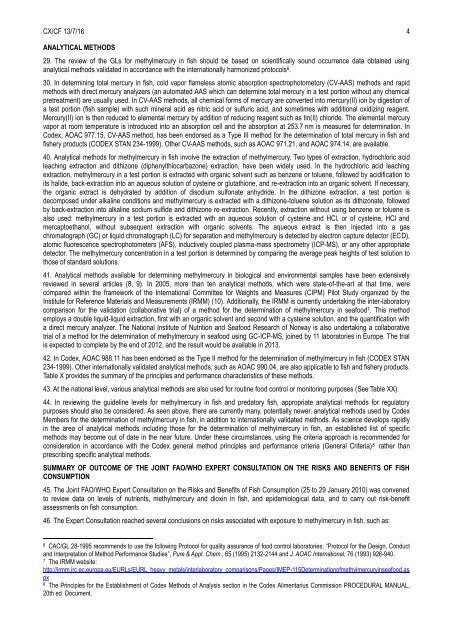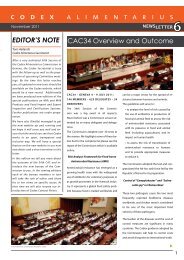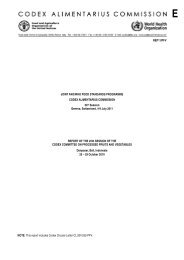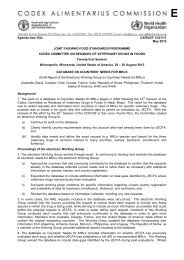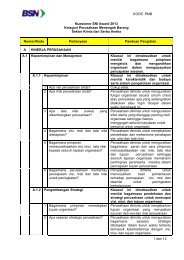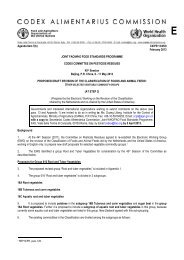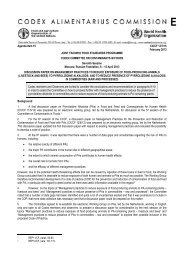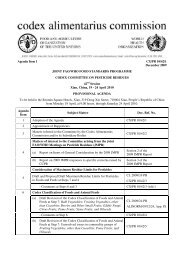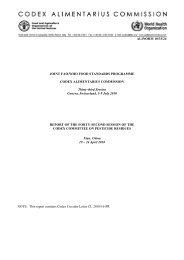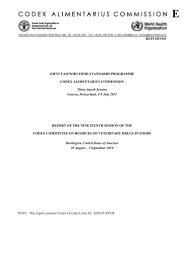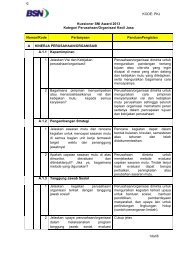Agenda Item 16 CX/CF 13/7/16 February 2013 JOINT FAO ... - FAO.org
Agenda Item 16 CX/CF 13/7/16 February 2013 JOINT FAO ... - FAO.org
Agenda Item 16 CX/CF 13/7/16 February 2013 JOINT FAO ... - FAO.org
- No tags were found...
You also want an ePaper? Increase the reach of your titles
YUMPU automatically turns print PDFs into web optimized ePapers that Google loves.
<strong>CX</strong>/<strong>CF</strong> <strong>13</strong>/7/<strong>16</strong> 4ANALYTICAL METHODS29. The review of the GLs for methylmercury in fish should be based on scientifically sound occurrence data obtained usinganalytical methods validated in accordance with the internationally harmonized protocols 6 .30. In determining total mercury in fish, cold vapor flameless atomic absorption spectrophotometory (CV-AAS) methods and rapidmethods with direct mercury analyzers (an automated AAS which can determine total mercury in a test portion without any chemicalpretreatment) are usually used. In CV-AAS methods, all chemical forms of mercury are converted into mercury(II) ion by digestion ofa test portion (fish sample) with such mineral acid as nitric acid or sulfuric acid, and sometimes with additional oxidizing reagent.Mercury(II) ion is then reduced to elemental mercury by addition of reducing reagent such as tin(II) chloride. The elemental mercuryvapor at room temperature is introduced into an absorption cell and the absorption at 253.7 nm is measured for determination. InCodex, AOAC 977.15, CV-AAS method, has been endorsed as a Type III method for the determination of total mercury in fish andfishery products (CODEX STAN 234-1999). Other CV-AAS methods, such as AOAC 971.21, and AOAC 974.14, are available.40. Analytical methods for methylmercury in fish involve the extraction of methylmercury. Two types of extraction, hydrochloric acidleaching extraction and dithizone (diphenylthiocarbazone) extraction, have been widely used. In the hydrochloric acid leachingextraction, methylmercury in a test portion is extracted with <strong>org</strong>anic solvent such as benzene or toluene, followed by acidification toits halide, back-extraction into an aqueous solution of cysteine or glutathione, and re-extraction into an <strong>org</strong>anic solvent. If necessary,the <strong>org</strong>anic extract is dehydrated by addition of disodium sulfonate anhydride. In the dithizone extraction, a test portion isdecomposed under alkaline conditions and methylmercury is extracted with a dithizone-toluene solution as its dithizonate, followedby back-extraction into alkaline sodium sulfide and dithizone re-extraction. Recently, extraction without using benzene or toluene isalso used: methylmercury in a test portion is extracted with an aqueous solution of cysteine and HCl, or of cysteine, HCl andmercaptoethanol, without subsequent extraction with <strong>org</strong>anic solvents. The aqueous extract is then injected into a gaschromatograph (GC) or liquid chromatograph (LC) for separation and methylmercury is detected by electron capture detector (ECD),atomic fluorescence spectrophotometers (AFS), inductively coupled plasma-mass spectrometry (ICP-MS), or any other appropriatedetector. The methylmercury concentration in a test portion is determined by comparing the average peak heights of test solution tothose of standard solutions.41. Analytical methods available for determining methylmercury in biological and environmental samples have been extensivelyreviewed in several articles (8, 9). In 2005, more than ten analytical methods, which were state-of-the-art at that time, werecompared within the framework of the International Committee for Weights and Measures (CIPM) Pilot Study <strong>org</strong>anized by theInstitute for Reference Materials and Measurements (IRMM) (10). Additionally, the IRMM is currently undertaking the inter-laboratorycomparison for the validation (collaborative trial) of a method for the determination of methylmercury in seafood 7 . This methodemploys a double liquid-liquid extraction, first with an <strong>org</strong>anic solvent and second with a cysteine solution, and the quantification witha direct mercury analyzer. The National Institute of Nutrition and Seafood Research of Norway is also undertaking a collaborativetrial of a method for the determination of methylmercury in seafood using GC-ICP-MS, joined by 11 laboratories in Europe. The trialis expected to complete by the end of 2012, and the result would be available in 20<strong>13</strong>.42. In Codex, AOAC 988.11 has been endorsed as the Type II method for the determination of methylmercury in fish (CODEX STAN234-1999). Other internationally validated analytical methods, such as AOAC 990.04, are also applicable to fish and fishery products.Table X provides the summary of the principles and performance characteristics of these methods.43. At the national level, various analytical methods are also used for routine food control or monitoring purposes (See Table XX).44. In reviewing the guideline levels for methylmercury in fish and predatory fish, appropriate analytical methods for regulatorypurposes should also be considered. As seen above, there are currently many, potentially newer, analytical methods used by CodexMembers for the determination of methylmercury in fish, in addition to internationally validated methods. As science develops rapidlyin the area of analytical methods including those for the determination of methylmercury in fish, an established list of specificmethods may become out of date in the near future. Under these circumstances, using the criteria approach is recommended forconsideration in accordance with the Codex general method principles and performance criteria (General Criteria) 8 rather thanprescribing specific analytical methods.SUMMARY OF OUTCOME OF THE <strong>JOINT</strong> <strong>FAO</strong>/WHO EXPERT CONSULTATION ON THE RISKS AND BENEFITS OF FISHCONSUMPTION45. The Joint <strong>FAO</strong>/WHO Expert Consultation on the Risks and Benefits of Fish Consumption (25 to 29 January 2010) was convenedto review data on levels of nutrients, methylmercury and dioxin in fish, and epidemiological data, and to carry out risk-benefitassessments on fish consumption.46. The Expert Consultation reached several conclusions on risks associated with exposure to methylmercury in fish, such as:6CAC/GL 28-1995 recommends to use the following Protocol for quality assurance of food control laboratories: “Protocol for the Design, Conductand Interpretation of Method Performance Studies”, Pure & Appl. Chem., 65 (1995) 2<strong>13</strong>2-2144 and J. AOAC International, 76 (1993) 926-940.7The IRMM website:http://irmm.jrc.ec.europa.eu/EURLs/EURL_heavy_metals/interlaboratory_comparisons/Pages/IMEP-115Determinationofmethylmercuryinseafood.aspx8The Principles for the Establishment of Codex Methods of Analysis section in the Codex Alimentarius Commission PROCEDURAL MANUAL,20th ed. Document.


